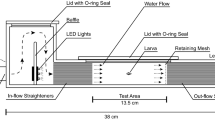Abstract
Understanding the movement patterns of fishes in the wild requires an awareness of the intrinsic and extrinsic factors underlying their behaviour. Using field observations, we explored whether eight species of coral reef fish display modality in their swimming behaviour, which is a convergence in fin use patterns among and within species when they conduct daily activities (e.g. feeding, travelling, chasing). While a range of different fins were used during steady swimming by each species, most fishes converged towards median-paired fin use (e.g. pelvics, pectorals) when undertaking searching and feeding. Conversely, all species adopted caudal fin use during high-speed activities such as chasing. Such modality in fin use was relatively conserved across juvenile and adult conspecifics and transcended differences in phylogenetic history and trophic preferences, suggesting that overarching constraints underpin patterns of fish swimming behaviour in complex habitats.



Similar content being viewed by others
References
Alexander RM (1989) Optimization and gaits in the locomotion of vertebrates. Physiol Rev 69:1199–1227
Blake RW (2004) Fish functional design and swimming performance. J Fish Biol 65:1193–1222
Breder CM (1926) The locomotion of fishes. Zoologica 4:154–297
Cannas M, Schaefer J, Domenici P, Steffensen JF (2006) Gait transition and oxygen consumption in swimming striped surfperch Embiotoca lateralis Agassiz. J Fish Biol 69:1612–1625
Drucker EG, Jensen JS (1996) Pectoral fin locomotion in the striped surfperch. I. Kinematic effects of swimming speed and body size. J Exp Biol 199:2235–2242
Fish FE (2000) Biomechanics and energetics in aquatic and semiaquatic mammals: platypus to whale. Physiol Biochem Zool 73:683–698
Fish FE (2010) Swimming strategies for energy economy. In: Domenici P, Kapoor BG (eds) Fish locomotion: an eco-ethological perspective. Science Publishers, Enfield
Fulton CJ (2007) Swimming speed performance in coral reef fishes: field validations reveal distinct functional groups. Coral Reefs 26:217–228
Fulton CJ (2010) The role of swimming in reef fish ecology. In: Domenici P, Kapoor BG (eds) Fish locomotion: an eco-ethological perspective. Science Publishers, Enfield
Fulton CJ, Bellwood DR (2002a) Ontogenetic habitat use in labrid fishes: an ecomorphological perspective. Mar Ecol Progr Ser 236:255–262
Fulton CJ, Bellwood DR (2002b) Patterns of foraging in labrid fishes. Mar Ecol Progr Ser 226:135–142
Gerstner C (1999) Maneuverability of four species of coral-reef fish that differ in body and pectoral-fin morphology. Can J Zool 77:1102–1110
Heatwole SJ, Fulton CJ (2013) Behavioural flexibility in reef fishes responding to a rapidly changing wave environment. Mar Biol 160:677–689
Johansen JL, Fulton CJ, Bellwood DR (2007) Avoiding the flow: refuges expand the swimming potential of coral reef fishes. Coral Reefs 26:577–583
Korsmeyer KE, Steffensen JF, Herskin J (2002) Energetics of median and paired fin swimming, body and caudal fin swimming, and gait transition in parrotfish (Scarus schlegeli) and triggerfish (Rhinecanthus aculeatus). J Exp Biol 205:1253–1263
Legendre P, Galzin R, Harmelin-Vivien ML (1997) Relating behaviour to habitat: solutions to the fourth-corner problem. Ecology 78:547–562
Lighthill MJ (1969) Hydromechanics of aquatic animal propulsion. Ann Rev Fluid Mech 1:413–446
Motta P (1983) Response by potential prey to coral reef predators. Anim Behav 31:1257–1259
Moyle PB, Cech JJ Jr (2004) Fishes: an introduction to ichthyology, 5th edn. Prentice-Hall Inc, Englewood Cliffs, NJ
Perry G, Pianka ER (1997) Animal foraging: past, present and future. TREE 12:360–364
Randall JE, Allen GR, Steene RC (1997) Fishes of the great barrier reef and coral sea, 2nd edn. Crawford House Publishing Pty Ltd, Bathurst
Rice AN, Hale ME (2010) Roles of locomotion in feeding. In: Domenici P, Kapoor BG (eds) Fish locomotion: an eco-ethological perspective. Science Publishers, Enfield
Sfakiotakis M, Lane DM, Davies JBC (1999) Review of fish swimming modes for aquatic locomotion. IEEE J Ocean Eng 24:237–252
Webb PW (1994) The biology of fish swimming. In: Maddock L, Bone Q, Rayner JMV (eds) Mechanics and physiology of animal swimming. Cambridge University Press, Cambridge
Webb PW, Fairchild AG (2001) Performance and maneuverability of three species of teleostean fishes. Can J Zool 79:1866–1877
Webb PW, Cotel A, Meadows LA (2010) Waves and eddies: effects on fish behaviour and habitat distribution. In: Domenici P, Kapoor BG (eds) Fish locomotion: an eco-ethological perspective. Science Publishers, Enfield
Weihs D (2002) Stability versus maneuverability in aquatic locomotion. Integr Comp Biol 42:127–134
Yamanoue Y, Setiamarga DHE, Matsuura K (2010) Pelvic fins in teleosts: structure, function and evolution. J Fish Biol 77:1173–1208
Acknowledgments
Our study was conducted at Jiigurru in the traditional sea country of the Dingaal people. We thank W. Townshend and Lizard Island Research Station staff for field assistance, H.-J. Yoon for statistical advice, the Australian Research Council (CJF) for funding, M. Noble for illustrations, C. Layton, M. Peck and two anonymous reviewers for helpful comments. Conducted with approval of the Great Barrier Reef Marine Park Authority and ANU Animal Experimentation Ethics Committee.
Author information
Authors and Affiliations
Corresponding author
Additional information
Communicated by M. A. Peck.
Rights and permissions
About this article
Cite this article
Pink, J.R., Fulton, C.J. Right tools for the task: intraspecific modality in the swimming behaviour of coral reef fishes. Mar Biol 161, 1103–1111 (2014). https://doi.org/10.1007/s00227-014-2403-0
Received:
Accepted:
Published:
Issue Date:
DOI: https://doi.org/10.1007/s00227-014-2403-0




